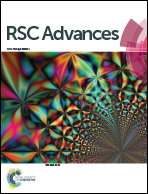Ab initio study of the excited-state proton transfer mechanisms for 3-hydroxy-2-(thiophen-2-yl)chromen-4-one†
Abstract
The optical absorption properties and fluorescence properties of 3-hydroxy-2-(thiophen-2-yl)chromen-4-one (3-HTC) were simulated by the time-dependent density functional theory (TDDFT) method. The experimental absorption spectrum and fluorescence spectrum were reproduced well by the calculated vertical excitation energies of 3-HTC-a, which corresponds to the intramolecular hydrogen bond O2⋯H1–O1. The excited state intramolecular proton transfer (ESIPT) mechanism of 3-HTC has been systematically investigated. The constructed potential energy curves (PECs) of 3-HTC-a in the S0 and S1 states indicate that, after photo-excitation, the intramolecular proton transfer reaction with the H1 atom moving from O1 to O2 occurs more readily in both the dynamics and thermodynamics aspects. In sharp contrast, the weak S⋯H1–O1 bond in 3-HTC-b was weakened in the S1 state compared with that in the S0 state, suggesting that the ESIPT process is forbidden. For the first time, it is found that the strong hydrogen bond is further strengthened and the weak hydrogen bond is further weakened in the excited state of 3-HTC. Moreover, the vibrational frequencies of the C![[double bond, length as m-dash]](https://www.rsc.org/images/entities/char_e001.gif) O and O–H groups involved in the hydrogen bonds were also studied, and a more clear-cut signature of the hydrogen-bonding dynamics of 3-HTC is provided in this work.
O and O–H groups involved in the hydrogen bonds were also studied, and a more clear-cut signature of the hydrogen-bonding dynamics of 3-HTC is provided in this work.



 Please wait while we load your content...
Please wait while we load your content...